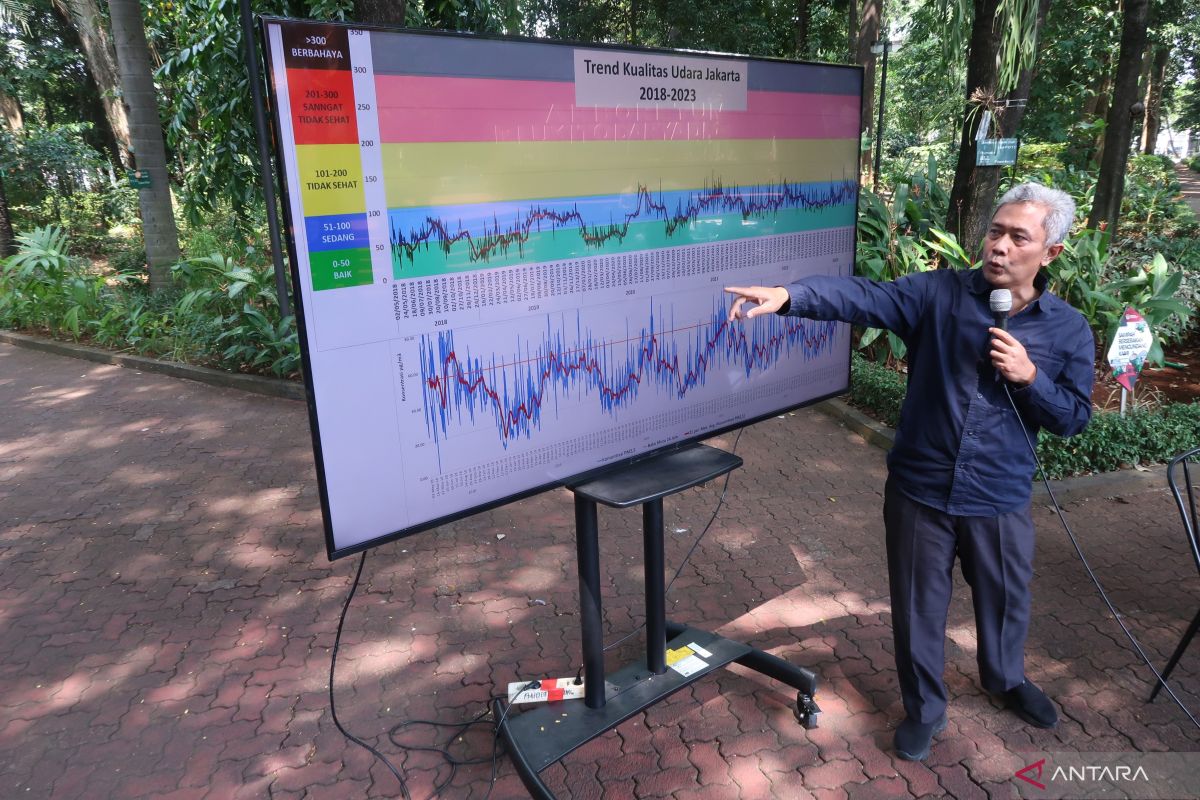Ministry urges low-emission lifestyle to improve air quality – ANTARA News
Ministry urges low-emission lifestyle to improve air quality ANTARA English


The Ministry of Environment and Forestry Urges Adoption of Low-Emission Lifestyle to Improve Air Quality in Urban Areas

Jakarta (ANTARA) – The Ministry of Environment and Forestry is urging people to adopt a low-emission lifestyle to improve air quality in urban areas.
Primary Cause of Air Pollution in Urban Areas
The ministry’s Director General of Pollution and Environmental Damage Control, Sigit Reliantoro, stated that the primary cause of air pollution in urban areas is the use of conventional vehicles fueled by oil.
Importance of Changing Lifestyle in Urban Areas
“Changing our lifestyle is crucial in urban areas,” he said during a discussion held in Jakarta on Sunday.
He explained that developed countries prioritize walking, followed by cycling, using public transportation, and adopting electric vehicles.
This lifestyle, which emphasizes walking and cycling for transportation, benefits both air quality and physical health, he added.
“The key concept in transportation is to increase the movement of people, not just the number of vehicles. Therefore, vehicle efficiency is of utmost importance,” Reliantoro emphasized.
Air Pollution Emissions in Jakarta
In 2020, Bloomberg Philanthropies and Vital Strategies published a report on air pollution emissions in Jakarta.
The report revealed the following fuel usage percentages in different sectors:
- Transportation sector – 44%
- Energy industry – 31%
- Housing – 14%
- Manufacturing – 10%
- Commercial – 1%
“This confirms the theory that street canyons are mainly caused by transportation activities,” he observed.
Street Canyon Effect and Air Quality Measurements
The street canyon effect in urban areas traps air pollution at ground level due to tall buildings blocking the wind. As a result, air quality measurements in urban areas consistently show levels unfavorable for human health.
When an air quality index measurement device is mounted on a building wall, it reflects the air’s condition at that specific location and not the overall ambient air quality.
Reliantoro noted that if a vehicle is used by only two people, it emits more pollutants than public transportation used by multiple individuals.
He cited Japan as an example, where walking, cycling, and using trains are prevalent among the population, making it one of the most efficient developed countries in this regard.
Initiatives in Jakarta
“Now, Jakarta has initiated the development of various public facilities such as pedestrian paths, bicycle lanes, improved public transportation, and even JakLingko (public minivans) navigating narrow streets,” he said.
He added that these facilities should be embraced to instill a culture similar to that of developed countries.
Related News
- Minister urges people to switch to EVs to improve air quality
- Jakarta to open 23 new parks to improve air quality
SDGs, Targets, and Indicators
| SDGs | Targets | Indicators |
|---|---|---|
| SDG 11: Sustainable Cities and Communities | 11.6: By 2030, reduce the adverse per capita environmental impact of cities, including by paying special attention to air quality and municipal and other waste management | Air quality measurements in urban areas consistently show levels unfavorable for human health |
| SDG 3: Good Health and Well-being | 3.9: By 2030, substantially reduce the number of deaths and illnesses from hazardous chemicals and air, water, and soil pollution and contamination | Air pollution in urban areas is primarily caused by the use of conventional vehicles fueled by oil |
| SDG 9: Industry, Innovation, and Infrastructure | 9.4: By 2030, upgrade infrastructure and retrofit industries to make them sustainable, with increased resource-use efficiency and greater adoption of clean and environmentally sound technologies and industrial processes | The transportation sector recorded the highest fuel usage (44 percent) |
1. Which SDGs are addressed or connected to the issues highlighted in the article?
SDG 11: Sustainable Cities and Communities
The article discusses the need to improve air quality in urban areas by adopting a low-emission lifestyle. This aligns with SDG 11, which aims to make cities and human settlements inclusive, safe, resilient, and sustainable.
SDG 3: Good Health and Well-being
The article highlights the adverse effects of air pollution on human health, emphasizing the need to reduce air pollution in urban areas. This relates to SDG 3, which focuses on ensuring healthy lives and promoting well-being for all at all ages.
SDG 9: Industry, Innovation, and Infrastructure
The article mentions the high fuel usage in the transportation sector, indicating the need to upgrade infrastructure and promote sustainable transportation. This connects to SDG 9, which aims to build resilient infrastructure, promote inclusive and sustainable industrialization, and foster innovation.
2. What specific targets under those SDGs can be identified based on the article’s content?
Target 11.6: By 2030, reduce the adverse per capita environmental impact of cities, including by paying special attention to air quality and municipal and other waste management
The article emphasizes the need to improve air quality in urban areas, which aligns with this target under SDG 11.
Target 3.9: By 2030, substantially reduce the number of deaths and illnesses from hazardous chemicals and air, water, and soil pollution and contamination
The article highlights the adverse effects of air pollution on human health, indicating the importance of reducing air pollution to achieve this target under SDG 3.
Target 9.4: By 2030, upgrade infrastructure and retrofit industries to make them sustainable, with increased resource-use efficiency and greater adoption of clean and environmentally sound technologies and industrial processes
The article mentions the need to upgrade infrastructure and promote sustainable transportation, which aligns with this target under SDG 9.
3. Are there any indicators mentioned or implied in the article that can be used to measure progress towards the identified targets?
The article mentions specific indicators that can be used to measure progress towards the identified targets:
– Air quality measurements in urban areas consistently show levels unfavorable for human health. This indicator can be used to measure progress towards Target 11.6 under SDG 11.
– The article highlights that air pollution in urban areas is primarily caused by the use of conventional vehicles fueled by oil. This indicates the need to reduce air pollution from transportation, which can be measured to track progress towards Target 3.9 under SDG 3.
– The transportation sector recorded the highest fuel usage (44 percent). This indicator can be used to measure progress towards Target 9.4 under SDG 9.
Overall, these indicators provide insights into the current state of air quality and the impact of transportation on air pollution, allowing for the monitoring of progress towards the identified targets.
SDGs, Targets, and Indicators
| SDGs | Targets | Indicators |
|---|---|---|
| SDG 11: Sustainable Cities and Communities | 11.6: By 2030, reduce the adverse per capita environmental impact of cities, including by paying special attention to air quality and municipal and other waste management | Air quality measurements in urban areas consistently show levels unfavorable for human health |
| SDG 3: Good Health and Well-being | 3.9: By 2030, substantially reduce the number of deaths and illnesses from hazardous chemicals and air, water, and soil pollution and contamination | Air pollution in urban areas is primarily caused by the use of conventional vehicles fueled by oil |
| SDG 9: Industry, Innovation, and Infrastructure | 9.4: By 2030, upgrade infrastructure and retrofit industries to make them sustainable, with increased resource-use efficiency and greater adoption of clean and environmentally sound technologies and industrial processes | The transportation sector recorded the highest fuel usage (44 percent) |
Behold! This splendid article springs forth from the wellspring of knowledge, shaped by a wondrous proprietary AI technology that delved into a vast ocean of data, illuminating the path towards the Sustainable Development Goals. Remember that all rights are reserved by SDG Investors LLC, empowering us to champion progress together.
Source: en.antaranews.com

Join us, as fellow seekers of change, on a transformative journey at https://sdgtalks.ai/welcome, where you can become a member and actively contribute to shaping a brighter future.







